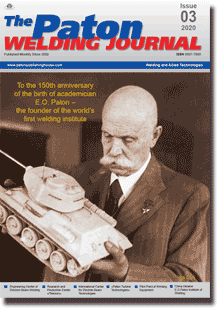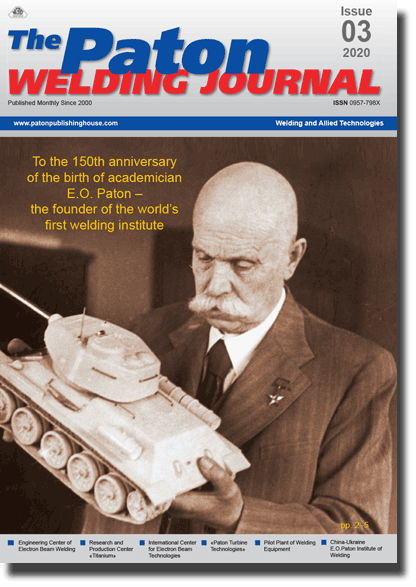| 2020 №03 (04) |
DOI of Article 10.37434/tpwj2020.03.05 |
2020 №03 (01) |

The Paton Welding Journal, 2020, #3, 34-40 pages
Brazing as a promising method of producing permanent joints
S.V. Maksymova
E.O. Paton Electric Welding Institute of the NAS of Ukraine 11 Kazymyr Malevych Str., 03150, Kyiv, Ukraine. E-mail: office@paton.kiev.ua
Abstract
The paper presents practical results of developments and investigations in the field of brazing different materials: aluminium, copper, high-temperature nickel and titanium alloys, as well as promising materials based on Ni3a1 and γ-Tial intermetallics and steels of different grades. Data on reactive-flux brazing of aluminium thin-walled structures in a controlled gas environment are given. a lot of attention is paid to producing brazed joints from dissimilar materials: Mo+c (stainless steel), W+cu, hard alloy material (vK 20)+steel, al+steel, etc. Effective application of the developed technologies of brazing high-temperature nickel and titanium alloys in fabrication of critical structures for high temperature applications and results of mechanical testing of brazed joints are shown. The developed brazing filler metal and technologies of high-temperature vacuum brazing were applied to produce joints from new generation alloys based on nickel and titanium aluminides, which have been successfully tested for long-term strength under the conditions of higher temperature and continuously applied stresses. 17 ref., 1 Table, 14 Figures.
Keywords: brazed joints, brazing filler metals, vacuum, reactive-flux, flame brazing, high-temperature nickel, titanium alloys, long-term strength, dissimilar materials, aluminium, copper alloys
Received 11.02.2020
References
1. Krasnopevtseva, I.V. (2018) Technical and economical advantages of application of brazing technology in mechanical engineering. In: Proc. of Int. Conf. on Brazing -2018. Tolyatti, TGU, 30-36.2. Yermolayev, G.V., Kvasnytskyi, V.V., Kvasnytskyi V.F. et al. (2015) Brazing of materials: Manual. Ed. by V.F. Khorunov, V.F.Kvasnytskyi. Mukolaiv, NUK [in Ukrainian].
3. Maly, A.B. (2008) Improvement of ChS-104 nickel-base alloy weldability by optimization of heat treatment mode. The Paton Welding J., 8, 7-10.
4. Kalin, B.A., Fedotov, V.T., Sevryukov, O.N. et al. (2005) Development and application of rapid quenched filler metals for precision brazing of dissimilar materials of nuclear engineering. Voprosy Atomnoj Nauki i Tekhniki, 5(88), 150-156 [in Russian].
5. Maksymova, S.V. (2007) Amorphous filler metals for brazing of stainless steel and titanium and structure of brazed joints. Adgeziya Rasplavov i Pajka Materialov, 40, 70-81 [in Russian].
6. Novosadov, V.S. (2018) Physicochemical and rheological principles of wetting and flowing in metallic systems. In: Proc. of Int. Conf. on Brazing -2018. Tolyatti, TGU, 101-120.
7. Pashkov, I.N., Bazlova, T.A., Bazhenov, V.E., Misnikov, V.E. (2018) Study of limiting wetting angles with nickel-based brazing filler metals on substate from corrosion-resistant steel 12Kh18N10Т and heat-resistant alloy VZh-159. In: Proc. of Int. Conf. on Brazing -2018. Tolyatti, TGU, 157-165.
8. Khorunov, V.F., Sabadash, O.M. (2013) Brazing of aluminium and aluminium to steel. Advances in brazing. In: Science, technology and applications. UK, WPL, Oxford Cambridge, 249-279. https://doi.org/10.1533/9780857096500.2.249
9. Khorunov, V.F., Maksymova, S.V., Stefaniv, B.V. (2010) Manufacture of drill bits for production of dispersed methane in mine working. The Paton Welding J., 6, 41-43.
10. (2020) https://ecotechnica.com.ua/energy/solntse/1023-delaem-prostoj-solnechnyi-kollektor-svoimi-rukami-poshagovaya-instruktsiya.
11. Rabinkin, A. (2013) Advances in brazing. In: Science, technology and applications. UK, WPL, Oxford Cambridge, 121-159. https://doi.org/10.1533/9780857096500.2.121
12. Malashenko, I.S., Kurenkova, V.V., Belyavin, A.F., Trokhimchenko, V.V. (2006) Short-term strength and microstructure of brazed joints of alloy VJL12U produced using boron-containing brazing alloy with addition of silicon. Advances in Electrometall, 4, 23-38.
13. Arafina, M.A., Medraja, M., Turnerb, D.P., Bocherc, P. (2007) Transient liquid phase bonding of Inconel 718 and Inconel 625 with BNi-2: Modeling and experimental investigations. Mater. Sci. & Engin.: A., 447(1-2), 125-133. https://doi.org/10.1016/j.msea.2006.10.045
14. Kablov, E.N., Lukin, V.I. (2008) Intermetallics based on titanium and nickel for advanced engineering products. The Paton Welding J., 11, 65-70.
15. Iliin, A.A., Kolachev, B.A., Polkin, I.S. (2009) Titanium alloys. Composition, structure, properties: Refer. book. Moscow, VILS-MATI [in Russian].
16. Khorunov, V.F., Maksymova, S.V. (2013) Brazing of superalloys and the intermetallic alloy (γ-TiAl). Advances in brazing. In: Science, technology and applications. WPL, Oxford Cambridge, 85-120. https://doi.org/10.1533/9780857096500.2.85
17. Khorunov, V.F. (2008) Fundamentals of brazing of thin-walled structures from high-alloyed steels. Kiev, Naukova Dumka [in Russian].
Suggested Citation
S.V. Maksymova (2020) Brazing as a promising method of producing permanent joints. The Paton Welding J., 03, 34-40.The cost of subscription/purchase order journals or individual articles
| Journal/Currency | Annual Set | 1 issue printed |
1 issue |
one article |
| TPWJ/USD | 384 $ | 32 $ | 26 $ | 13 $ |
| TPWJ/EUR | 348 € | 29 € | 24 € | 12 € |
| TPWJ/UAH | 7200 UAH | 600 UAH | 600 UAH | 280 UAH |
| AS/UAH | 1800 UAH | 300 UAH | 300 UAH | 150 UAH |
| AS/USD | 192 $ | 32 $ | 26 $ | 13 $ |
| AS/EUR | 180 € | 30 € | 25 € | 12 € |
| SEM/UAH | 1200 UAH | 300 UAH | 300 UAH | 150 UAH |
| SEM/USD | 128 $ | 32 $ | 26 $ | 13 $ |
| SEM/EUR | 120 € | 30 € | 25 € | 12 € |
| TDNK/UAH | 1200 UAH | 300 UAH | 300 UAH | 150 UAH |
| TDNK/USD | 128 $ | 32 $ | 26 $ | 13 $ |
| TDNK/EUR | 120 € | 30 € | 25 € | 15 € |
AS = «Automatic Welding» - 6 issues per year;
TPWJ = «PATON WELDING JOURNAL» - 12 issues per year;
SEM = «Electrometallurgy Today» - 4 issues per year;
TDNK = «Technical Diagnostics and Non-Destructive Testing» - 4 issues per year.


